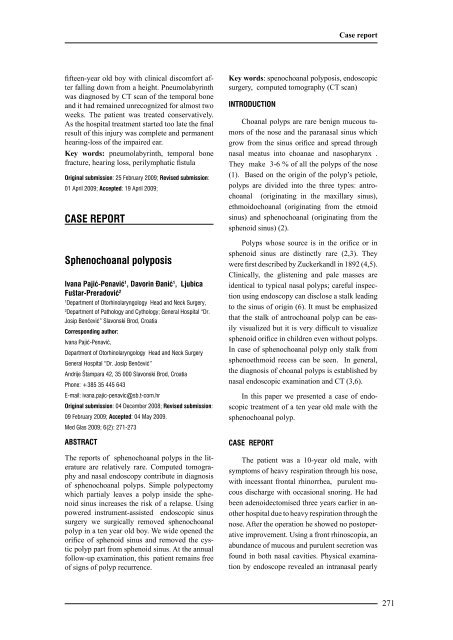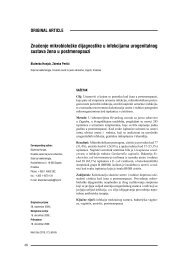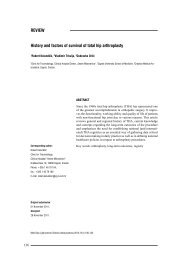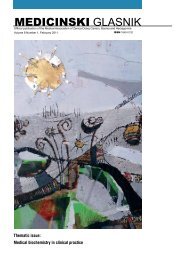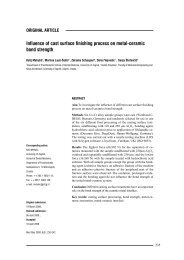MEDICINSKI GLASNIK
MEDICINSKI GLASNIK
MEDICINSKI GLASNIK
You also want an ePaper? Increase the reach of your titles
YUMPU automatically turns print PDFs into web optimized ePapers that Google loves.
fifteen-year old boy with clinical discomfort after<br />
falling down from a height. Pneumolabyrinth<br />
was diagnosed by CT scan of the temporal bone<br />
and it had remained unrecognized for almost two<br />
weeks. The patient was treated conservatively.<br />
As the hospital treatment started too late the final<br />
result of this injury was complete and permanent<br />
hearing-loss of the impaired ear.<br />
Key words: pneumolabyrinth, temporal bone<br />
fracture, hearing loss, perilymphatic fistula<br />
Original submission: 25 February 2009; Revised submission:<br />
01 April 2009; Accepted: 19 April 2009;<br />
CASE REPORT<br />
Sphenochoanal polyposis<br />
Ivana Pajić-Penavić 1 , Davorin \anić 1 , Ljubica<br />
Fuštar-Preradović 2<br />
1 Department of Otorhinolaryngology Head and Neck Surgery,<br />
2 Department of Pathology and Cythology; General Hospital “Dr.<br />
Josip Benčević” Slavonski Brod, Croatia<br />
Corresponding author:<br />
Ivana Pajić-Penavić,<br />
Department of Otorhinolaryngology Head and Neck Surgery<br />
General Hospital “Dr. Josip Benčević’’<br />
Andrije Štampara 42, 35 000 Slavonski Brod, Croatia<br />
Phone: +385 35 445 643<br />
E-mail: ivana.pajic-penavic@sb.t-com.hr<br />
Original submission: 04 December 2008; Revised submission:<br />
09 February 2009; Accepted: 04 May 2009.<br />
Med Glas 2009; 6(2): 271-273<br />
ABSTRACT<br />
The reports of sphenochoanal polyps in the literature<br />
are relatively rare. Computed tomography<br />
and nasal endoscopy contribute in diagnosis<br />
of sphenochoanal polyps. Simple polypectomy<br />
which partialy leaves a polyp inside the sphenoid<br />
sinus increases the risk of a relapse. Using<br />
powered instrument-assisted endoscopic sinus<br />
surgery we surgically removed sphenochoanal<br />
polyp in a ten year old boy. We wide opened the<br />
orifice of sphenoid sinus and removed the cystic<br />
polyp part from sphenoid sinus. At the annual<br />
follow-up examination, this patient remains free<br />
of signs of polyp recurrence.<br />
Key words: spenochoanal polyposis, endoscopic<br />
surgery, computed tomography (CT scan)<br />
INTRODUCTION<br />
Choanal polyps are rare benign mucous tumors<br />
of the nose and the paranasal sinus which<br />
grow from the sinus orifice and spread through<br />
nasal meatus into choanae and nasopharynx .<br />
They make 3-6 % of all the polyps of the nose<br />
(1). Based on the origin of the polyp’s petiole,<br />
polyps are divided into the three types: antrochoanal<br />
(originating in the maxillary sinus),<br />
ethmoidochoanal (originating from the etmoid<br />
sinus) and sphenochoanal (originating from the<br />
sphenoid sinus) (2).<br />
Polyps whose source is in the orifice or in<br />
sphenoid sinus are distinctly rare (2,3). They<br />
were first described by Zuckerkandl in 1892 (4,5).<br />
Clinically, the glistening and pale masses are<br />
identical to typical nasal polyps; careful inspection<br />
using endoscopy can disclose a stalk leading<br />
to the sinus of origin (6). It must be emphasized<br />
that the stalk of antrochoanal polyp can be easily<br />
visualized but it is very difficult to visualize<br />
sphenoid orifice in children even without polyps.<br />
In case of sphenochoanal polyp only stalk from<br />
sphenoethmoid recess can be seen. In general,<br />
the diagnosis of choanal polyps is established by<br />
nasal endoscopic examination and CT (3,6).<br />
In this paper we presented a case of endoscopic<br />
treatment of a ten year old male with the<br />
sphenochoanal polyp.<br />
CASE REPORT<br />
Case report<br />
The patient was a 10-year old male, with<br />
symptoms of heavy respiration through his nose,<br />
with incessant frontal rhinorrhea, purulent mucous<br />
discharge with occasional snoring. He had<br />
been adenoidectomised three years earlier in another<br />
hospital due to heavy respiration through the<br />
nose. After the operation he showed no postoperative<br />
improvement. Using a front rhinoscopia, an<br />
abundance of mucous and purulent secretion was<br />
found in both nasal cavities. Physical examination<br />
by endoscope revealed an intranasal pearly<br />
271


